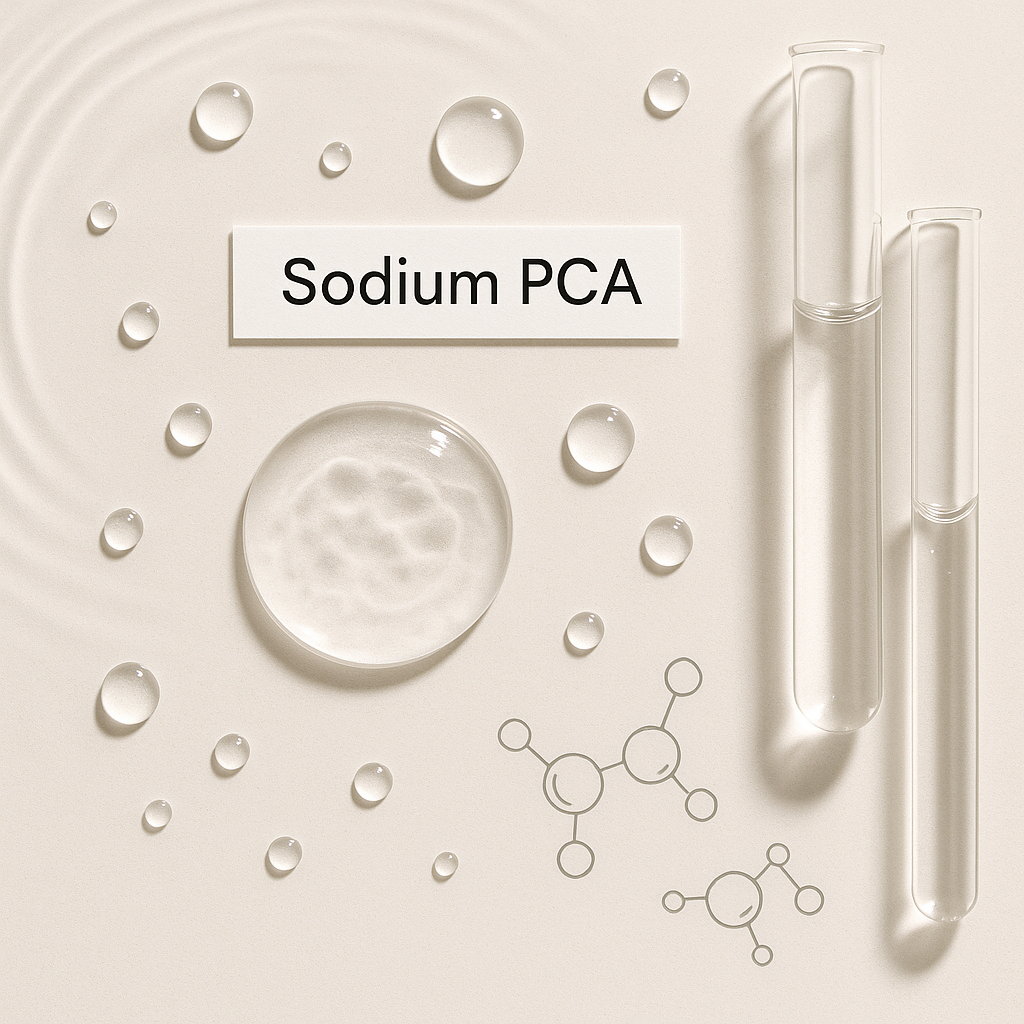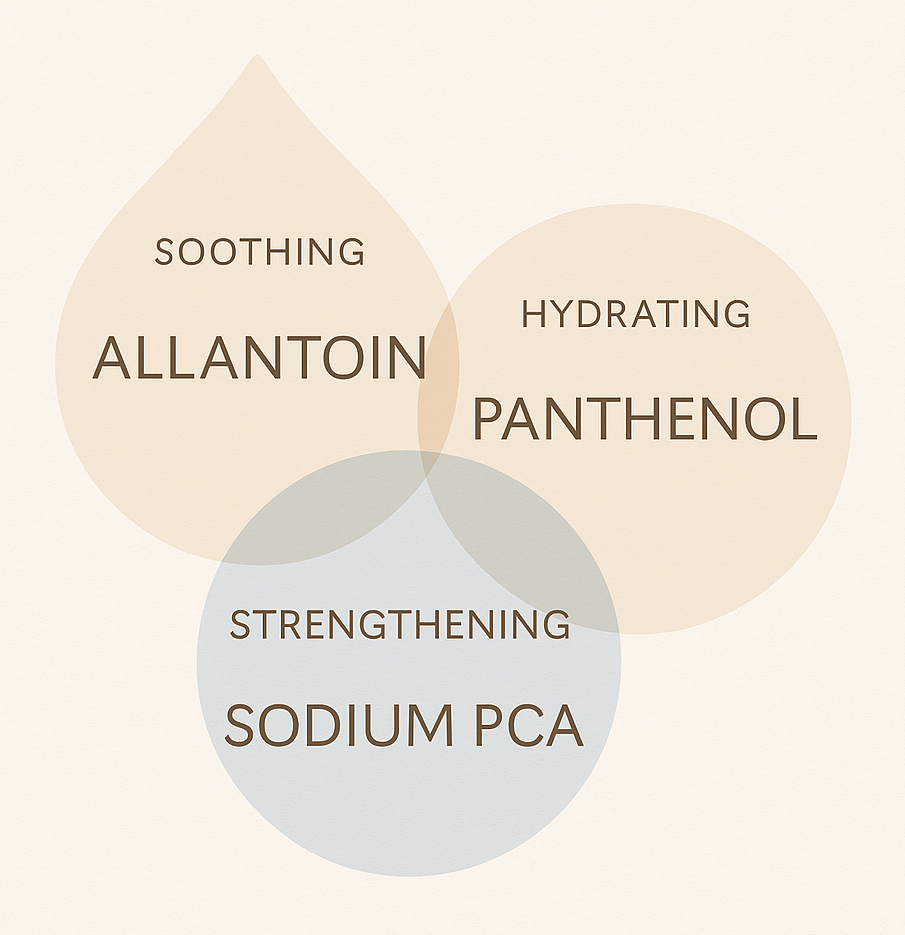
The Triple Repair Power Behind Our Bestselling Moisturizer
What Does “Triple Repair” Really Mean?
In skincare, "triple repair" isn’t just a catchphrase—it represents a strategic combination of ingredients that each target a different aspect of hydration barrier repair. At its core, it means a moisturizer that goes beyond basic hydration: one that soothes, restores, and strengthens the skin barrier to deliver long-lasting results.
Meet the Power Trio: Allantoin, Panthenol, and Sodium PCA
These three science-backed skincare ingredients work in harmony to restore moisture, reduce irritation, and reinforce the skin’s defense system. Think of them as your skin’s repair crew—each member bringing a unique strength to help heal and protect damaged skin.

Why These 3 Ingredients Matter for Summer Skin
Between UV exposure, sweat, chlorine, and over-cleansing, your skin takes a seasonal beating. The trio of Allantoin, Panthenol (Vitamin B5), and Sodium PCA provides the perfect remedy for summer’s top challenges: sun-induced dryness, redness, and post-exposure irritation.

What Makes Our Moisturizer Different from Others?
Unlike trendy formulations with long ingredient lists and little function, this triple action moisturizer is minimalist and purposeful. It doesn’t just hydrate—it strengthens, repairs, and improves skin texture with every use. It’s the deeply hydrating and soothing moisturizer you actually feel working.
The Role of Allantoin: Skin Soothing and Cell Renewal
How Allantoin Works on a Cellular Level
Allantoin benefits for skin stem from its ability to stimulate keratinocyte proliferation, encouraging skin renewal while creating a protective film over the surface. It helps maintain hydration levels and reduces trans-epidermal water loss (TEWL).

Why It’s Ideal for Sensitive or Irritated Skin
Allantoin is non-sensitizing, non-toxic, and anti-inflammatory. It calms flare-ups and reduces itchiness, making it a go-to for barrier repair moisturizer formulations.
Allantoin’s Benefits for Summer Sun Recovery
After sun exposure, skin needs support to heal and regenerate. Allantoin speeds recovery by enhancing cellular turnover while keeping the skin soothed and hydrated.
Panthenol: The Hydrating Healer
What Is Panthenol and Why Does Skin Love It?
Panthenol is a provitamin of B5. Upon contact with the skin, it converts to pantothenic acid, a key player in hydration and healing. It penetrates deeply to bind water and prevent moisture loss.
Strengthening the Skin Barrier with Pro-Vitamin B5
Panthenol reinforces the skin’s lipid layer, helping to restore the moisture barrier. It also builds tolerance, reducing reactivity in stressed skin.
Panthenol’s Role in Calming Redness and Inflammation
This vitamin B5 derivative is prized for its anti-inflammatory effect, particularly on skin prone to redness, sunburn, or friction. It’s essential in any soothing and repairing face cream.

Sodium PCA: The Skin’s Natural Moisturizing Factor
How Sodium PCA Mimics Healthy, Youthful Skin
Sodium PCA for skin hydration is a humectant naturally found in our skin. It draws moisture into the outer layers, mimicking what healthy, youthful skin produces on its own.
Sodium PCA vs Hyaluronic Acid: What’s Better in Heat and Humidity?
In high humidity, Sodium PCA shines. It hydrates without stickiness and absorbs quickly. Unlike hyaluronic acid, which can feel tacky or pull moisture from deeper layers in dry air, Sodium PCA is more balanced and effective.
Locking in Moisture Without Feeling Heavy
Its lightweight, non-greasy texture makes it ideal for summer. It supports hydration barrier repair without overwhelming the skin.

Why This Moisturizer Works in the Summer
Fighting Dehydration from Sun and Heat
Daily exposure to heat and UV rays depletes your skin’s moisture. This formula restores hydration without the suffocating weight of traditional creams.
Preventing Summer Breakouts with Lightweight Hydration
This barrier repair moisturizer absorbs cleanly, keeping pores clear while hydrating deeply. It supports oily and acne-prone skin through seasonal shifts.
Rebalancing Skin After Sunscreen, Sweat, and Shaving
Sun care, sweat, and daily shaving can cause irritation and imbalance. Triple repair helps reset the skin, calming inflammation and restoring comfort.

The Synergy Behind the Science: Why These Three Work Better Together
How Panthenol Boosts Allantoin’s Soothing Power
When used together, Panthenol enhances Allantoin’s calming effect. The two work synergistically to reduce redness and prevent post-exposure irritation.
Sodium PCA’s Ability to Maximize Hydration Absorption
By increasing moisture uptake, Sodium PCA creates an ideal environment for Allantoin and Panthenol to perform optimally.
Combined Effect: Smoother, Plumper, Resilient Skin
This combination targets dehydration, inflammation, and rough texture. The result? Stronger, more radiant skin that recovers faster and looks healthier.

Is Triple Repair Right for Your Skin Type?
Oily Skin in Summer: Benefits Without Buildup
This moisturizer offers hydration barrier repair with zero greasiness. It balances oil production without clogging pores.
Dry Skin: Deep Moisture Without the Grease
If you struggle with flaky, tight skin, this is the deeply hydrating and soothing moisturizer that melts in and restores comfort.
Mature Skin: Support for Collagen and Elasticity
By reducing inflammation and retaining water, it supports long-term elasticity and plumpness. A gentle anti-aging moisturizer that works.
Reactive Skin: Calm, Repair, and Strengthen
For skin that overreacts to almost everything, this formula offers calm. It strengthens the skin barrier and reduces sensitivity over time.

Suitable for All Skin Types
The Science That Supports Our Formula
Clinical Research on Allantoin, Panthenol, and Sodium PCA
- Allantoin: Anti-irritant and keratolytic properties (Int J Toxicol. 2010)
- Panthenol: Moisturizing and barrier-enhancing (Am J Clin Dermatol. 2005)
- Sodium PCA: Humectant efficacy and moisture retention (Cosmetics & Toiletries, 2004)
Why We Chose These Over Trendy Alternatives
We prioritize ingredients that perform consistently, with peer-reviewed data and proven safety. No gimmicks—just results.
Why We Don’t Follow Skincare Fads
The Problem With “Glass Skin” and Over-Exfoliation
Trendy regimens often compromise your skin barrier in pursuit of perfection. That dewy glow? Often oily-looking, temporary, and damaging.
Our Philosophy: Fewer Ingredients, Better Results
We don’t chase hype. We formulate with clarity, using ingredients your skin recognizes and benefits from long-term.
Bonus: How to Tell if Your Skin Barrier Needs Repair
Signs Your Barrier Is Compromised
- Flakiness
- Persistent redness
- Itchiness or stinging
- Increased breakouts or sensitivity

Get Glowing: Why Simplicity Is the Secret to Healthy Summer Skin
A restored hydration barrier is the foundation of resilient, glowing skin. When your skin is calm, moisturized, and protected, everything else looks better—makeup applies smoothly, pigment fades faster, and your complexion feels balanced.

Learn More: Meet Lancolia’s Triple Action Moisturizer
Essence de Jeunesse is Lancolia’s bestselling face moisturizer for a reason. It’s powered by Allantoin, Panthenol, and Sodium PCA—the triple repair blend that supports hydration barrier repair all summer long. If you’re looking for a gentle anti-aging moisturizer that smooths, soothes, and strengthens in one step, discover the formula trusted by women who want results without the fuss.
Frequently Asked Questions about Essence de Jeunesse and our Barrier Repair Ingredients
Can I Use It With Retinoids or Vitamin C?
You do not need to use Retinoids nor Vitamin C with our moisturizer. Our formula is packed with more powerful peptides and antioxidants than using retinol or vitamin C. When we say simple, we mean it!
How Often Should I Apply It in Summer?
Use daily, morning and night. Reapply after sun exposure or exfoliation for optimal hydration barrier repair.
Will It Work Under Sunscreen or Makeup?
Absolutely. Its lightweight texture layers beautifully under SPF and makeup, acting as a smoothing primer.
References:
- International Journal of Toxicology. (2010). "Safety Assessment of Allantoin."
- Lodén, M. (2003). "Role of topical emollients in barrier disorders." Am J Clin Dermatol"
- Thornfeldt, C. (2005). "Cosmeceuticals containing herbs: fact, fiction, and future." Dermatol Surg."
